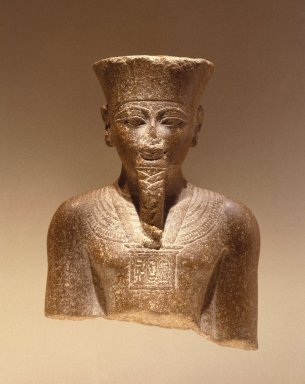Object of the Month: April 2010: Pair Statue of Nebsen and Nebet-ta
It is pretty timely that this month’s object for discussion is the Pair Statue of Nebsen and Nebet-ta . I absolutely adore this sculpture because it is one of the best examples of art made during the reign of Amunhotep III. Coincidentally, in this past month Egyptian archeologists found a red granite head of Amunhotep III among other artifacts buried in ancient ruins.
Pair Statue of Nebsen and Nebet-ta, ca. 1400-1352 B.C.E. Limestone, painted, 15 3/4 x 8 9/16 x 9 1/4 in. (40 x 21.8 x 23.5 cm). Brooklyn Museum, Charles Edwin Wilbour Fund, 40.523.
Nebsen and his wife, Nebet-ta, lived at the end of the 15th century B.C.E., but this statue on view in the museum, was commissioned by their son, Weserhat, only after they died. Like today, fashions changed in ancient Egypt, and since Weserhat lived during the reign of Amunhotep III (circa 1390-1352 B.C.E.), he ordered the sculpture to be carved in the style of the day. Just compare the large almond-shaped eyes, curved eyebrows, broad noses and full sensuous lips of Nebsen and Nebet-ta with Amun-Re or Amunhotep III.
Amun-Re or King Amunhotep III, 1403-1365 B.C.E. Quartzite, 7 11/16 x 5 5/8 x 3 15/16 in. (19.5 x 14.3 x 10 cm). Brooklyn Museum, Charles Edwin Wilbour Fund, 76.39.
Have you ever noticed that ancient Egyptian statues all look like the ruling pharaoh? Most likely, Nebsen and Nebet-ta did not actually resemble the king, but the artists were not striving to make portraits. By adopting the ruler’s features the artist associated the persons he was depicting with the king. This way, they could magically receive protection and reward in the afterlife, just like their king.
The inscriptions on the back of the object identify the owners by name. They also tell us that Nebsen was a scribe in the royal treasury, and Nebet-ta was a singer in the temple of Isis. The texts on this statue also describe the food and drink offerings for the ka-spirits of Nebsen and Nebet-ta. The inscription here wishes that Nebsen have “a fine memorial in his town, and that his ka-spirit be nourished daily…” The ancient Egyptians believed that one’s ka-spirit, created at the time of birth, continued to exist in this world after the person died. This is why sculptures like this, known as ka-statues, were created. They were placed in tombs or temples, and were thought to serve as a home for the ka-spirit, a place where it could receive offerings from the living family and the gods.
Nebsen’s offering formula appeals to the god Amun, One Enduring of Everything. Nebet-ta’s text connects this statue with the Brooklyn Museum because it summons Mut, the Lady of Isheru, whose temple precinct at Karnak is being excavated by the Brooklyn Museum expedition.

Egyptologist Yekaterina Barbash joined the Brooklyn Museum in 2008. A onetime intern in the Museum’s department of Egyptian, Classical, and Ancient Middle Eastern Art, Barbash received a Ph.D. in ancient Egyptian history, Art, and Philology from the Johns Hopkins University, Baltimore, where she was also awarded an M.A. She is the recipient of a B.A. from New York University and has studied at the Netherlands Institute of Archaeology and Arabic Studies in Cairo, Egypt. Dr. Barbash has taught at New York University’s School of Continuing and Professional Studies, Berkeley College, The College of New Jersey, and Staten Island CUNY. She has been a member of the Johns Hopkins University expedition to the Mut Precinct in Karnak, Egypt, where the Brooklyn Museum also maintains an excavation, and was a researcher at the Walters Art Museum.


